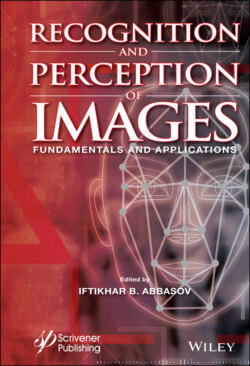Читать книгу Recognition and Perception of Images - Группа авторов - Страница 48
1.5.7 Illusions of Contrast
ОглавлениеThe illusion of contrast lies in the distortion of the perception of stimuli, due to the influence of the opposite, contrast or contextual stimulus. These include the illusions of Ebbingauz, Yastrov, Baldwin. The two inner circles are identical, but the area of the left central circle on the left seems larger because it is surrounded by smaller circles, and the area of the circle on the right is smaller, as it is surrounded by larger circles. Presented in Figure 1.5.8 on the right, Yastrov’s illusion also illustrates the effect of contrast on the perception of magnitude. The lower curved figure appears longer than the upper figure, although they are identical.
It should be noted that any signal is rarely perceived in isolation; therefore the connections between the signal and its context can influence the process of perception. Figure 1.5.9 shows Baldwin’s illusion: two pairs of squares of different sizes are connected by jumpers of the same size. The central jumper between the lower squares of a larger size seems a bit shorter than the one between the upper squares. The squares bounding these lines affect the perception of their length and lead to its distortion. Therefore, we cannot neglect the existing context, affecting the perception of the main signal.
Figure 1.5.7 Horizontal Vertical Wundt Illusion.
Figure 1.5.8 Illusion of Ebbingauz and Yastrov’s.
Figure 1.5.9 Influence of context on apparent length, Baldwin’s illusion.
In Figure 1.5.10, on the left are the illusions based on the contrast of the slope; the vertical lines appear to be inclined in the direction opposite to the slope of the surrounding background lines. The effect of contrast is illustrated by the illusions of Wundt and Goring (Figure 1.5.10, right).
Both pairs of horizontal lines are straight lines parallel to each other, but in Wundt illusions, they seem to be “bent” inward, and in Goring’s illusion, outward. A similar distortion of perception as a result of the contrast between two adjacent fragments is also characteristic of the Fraser illusion (Figure 1.5.11) [Website istockphoto, 2020].
The contrast between adjacent white and black rectangles distorts the perception of physically parallel lines in the illusion of Münsterberg (Figure 1.5.12). The illusion of non-parallelism is strong enough, it can only be destroyed with the help of a ruler.
Many visual illusions are the result of the combination of various illusory effects. For example, the Zander parallelogram presented in Figure 1.5.13 also contains the components of the Muller-Lyer illusion [Abbasov, 2019].
Figure 1.5.10 Illusions based on contrast tilt.
Figure 1.5.11 Fraser’s Illusion.
Figure 1.5.12 Illusion of Münsterberg.
Figure 1.5.13 Zander parallelogram, AB and AC are equal.
